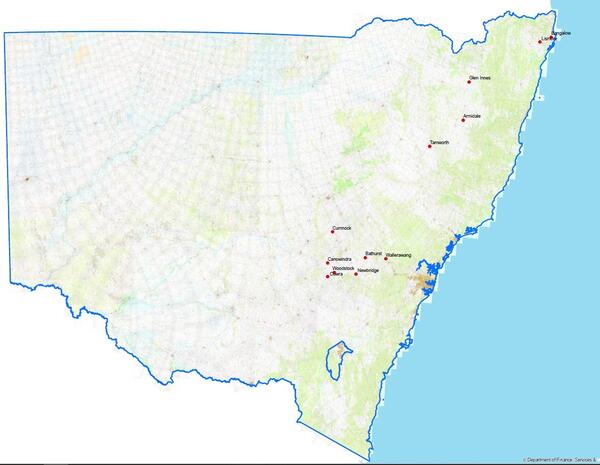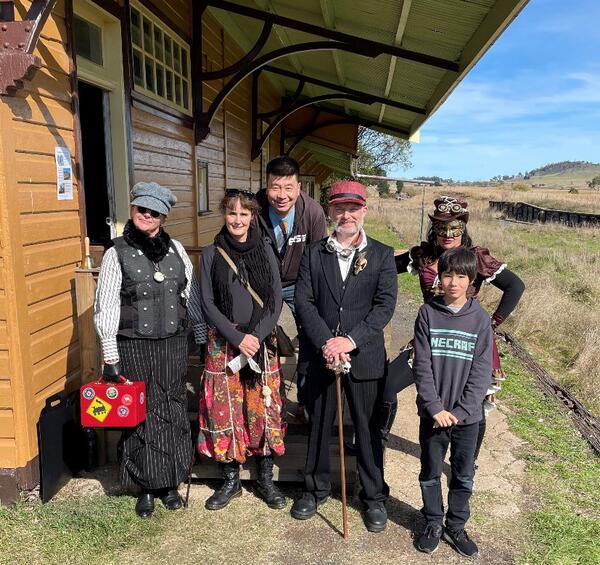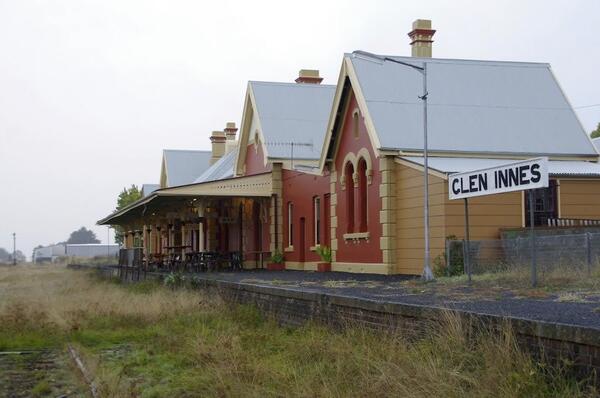Renewal and Heritage program
Project overview
Image

Image controls:
Program information
Background
The Renewal and Heritage team works with regional communities and businesses to reactivate under-utilised Transport for NSW assets on the Country Regional Network (CRN). The CRN extends north, west and south across regional NSW and covers some 27,000 hectares.
Our programs are not just about getting tenants into buildings but rather about how we can facilitate sustainable uses of rail assets that support the community.
The CRN is owned by the Transport Asset Manager of NSW (TAM) and is operated and maintained under contract (O&M Deed) by UGL Regional Linx (UGLRL).
UGLRL is the Rail Infrastructure Manager (RIM) for the CRN. The Renewal and Heritage team sits within the Regional Property and Asset Renewal (RPAR) team and is part of the Regional and Outer Metropolitan division (ROM) for Transport for NSW. It is tasked with delivering value added property solutions, connecting regions and improving communities.
Community engagement
We start from a simple principle: that local communities best understand their needs. Taking this as a starting point, we speak to communities about how we can work with them to find the best activation potentials.
This could be speaking directly to local councils, regional organisations (Regional Arts Development Organisations, Joint Regions of Councils) or community groups and associations.
Once potential activations have been identified we can then start to work on what a renewal project would look like, including potential uses and funding avenues.
Early-stage planning allows us and our project partners to start to look at other funding sources that can be used to enhance and deliver our projects.
Renewal and Heritage process
1. Consultation
Our team will visit regional NSW to talk to local councils and regional organisations (Regional Arts Development Organisations, Joint Regions of Councils) or community groups and associations to talk face to face, preferably at the proposed site.
We aim to understand how we can work with councils and regional organisations to find the best activation potentials.
At this stage, a broad discussion is held for the site. We also take the opportunity to discuss our program and how it aligns with potential uses and the site.
2. Identification
Projects start by applicants coming to us or we identify a use for a site from the consultation process.
Once we have the council and community on board we evaluate the site’s suitability for the proposed use.
3. Site evaluation
We conduct a detailed due diligence investigation. Contamination, site safety, suitability, allowable land use and impacts to any existing leases or licences are understood and given clearance. Site suitability for the proposed use is confirmed.
4. Scoping
A scope of works is developed in conjunction with the applicant. This may entail an optional site visit with the applicant and UGLRL representative to go through requirements to make the site good for the proposed use.
UGLRL undertakes the works based on the scope of works. This could involve minor works or major refurbishment to make the site suitable for the proposed use.
5. Approval
TfNSW requires various approvals to undertake works on TAHE-owned assets and any change of use for those assets.
6. Lease/License
The applicant will need to follow the UGLRL lease/licencing process.
7. Works and sign off
Approved enhancement works, completion certificates and lease/licence execution are all conducted in parallel.
Map
Our team is working across the state with councils and communities to see how we can activate assets. Download the map (PDF, 4.5 MB) to view the communities we are working with across NSW.
Community information
Frequently asked questions
Can the public access former rail sites?
Yes. Sites on the Country Regional Network (CRN) can be leased for fixed periods (under 5 years) or licensed (up to 10 years) or for one-off events. Enquiries should be directed to the UGL Regional Linx (UGLRL).
You will be requested to complete an application form.
Who can apply to occupy sites?
Anyone from an individual, company, community group or not-for-profit organisation.
What sorts of uses are allowed by TfNSW?
There are currently a wide range of allowable land uses for property on the CRN including:
- commercial uses
- grazing and access
- community uses
- one-off events
- cultural activities.
Is there an application fee?
Yes. Applicants will be advised of the amount by UGLRL when they submit an enquiry via their property website.
If I am not successful will this fee be refunded?
No. This is a non-refundable application fee.
We are a community organisation and registered as a not-for-profit; can we seek to have this fee waived?
Consideration to waive this fee is assessed on a case-by-case basis. Requests, including justification for the waiving of this fee should be made early in the process.
Are some land uses not allowed?
There are limitations on potential uses and these relate to the local council requirements, environmental and operational requirements for the CRN. These will be assessed during the application process.
What is the outcome of an application?
Your application may be approved, approved with conditions or rejected; you will be notified in writing of the outcome.
Will I be required to sign a lease or licence agreement if the application is approved?
Yes. TfNSW uses legal agreements for managing all of its assets. This will outline the terms and conditions of the occupation, responsibilities of both parties, annual rental and other special conditions.
How much is rent?
Rents are assessed in accordance with the Schedule of Fees and determined on a case- by-case basis and are dependent on the site, its location, the proposal and land use requirements.
This will be discussed with applicants during various stages of the process and prior to offering a lease or licence.
Should I speak to my local council prior to commencing an application?
Yes. Applicants must ensure that their proposed use is consistent with the land zoning and make sure they understand any local council approval requirements for their proposed land use, such as the lodgement of a Development Application.
Does the granting of a lease or licence mean I do not need local council approval for a use?
No. The granting of a lease or licence only means that you have entered into an agreement with TfNSW for the use of their land.
Applicants must obtain any relevant local council or other state government approvals (such as Heritage NSW) where relevant prior to signing any legal documents.
Do I need to have my potential land uses identified?
Yes. For TfNSW to consider entering into a lease or licence we need to know what the site will be used for and how it will be used in as much detail as possible. The proposed use must be considered in the context of environmental issues, allowable land use and any safety requirements.
Is there someone I can talk to about my proposal before making a formal application?
Any initial enquires should be directed to UGLRL property services.
Can we see a site before we make an application?
Site inspections can be organised through UGLRL.
Does our group need insurance?
Yes. As well as holding relevant insurances you will be required to ensure that the landowner is named as jointly insured on your policies. UGLRL can assist with advice on the necessary insurance levels including any requests for an insurance concession.
What is the process?
Once your initial enquiry is registered the process in broad terms is as follows:
- Provide detail of proposed land use and include all other information that is required in the pro-forma.
- Pay the non-refundable application fee.
- The application will undergo internal assessments and clearances to consider the viability of the application in the context of environmental, operational and safety requirements.
- If any additional information is required, this will be sought directly from the applicant and will restart the clock.
- Relevant insurances will be sought from the applicant, if not already provided in the application.
- Once internal clearances are obtained, the property team will contact you and initiate the final process for occupying CRN land.
- A letter of offer and a copy of the draft legal document will be provided to the applicant for their acceptance and review.
- All applicants are encouraged to obtain their own independent legal advice prior to executing any legal documents.
Once all negotiations are complete the legal document can be signed by the parties.
What sorts of things may prevent your proposed use?
The main issues that generally arise in assessing applications are as follows:
- Environmental: All railway corridors are generally deemed to be contaminated unless proven otherwise by sample testing. Contamination risk arises from both the construction (e.g. unknown fill used in rail construction) and operations (e.g. transportation of contaminated material, spills) of the railway. The type and level of contamination will impact potential uses. For example, some sites may be able to have a commercial use but not a sensitive use due to the levels and type of contamination.
- Operational: The CRN is a partially operational rail network, and any use must be able to be undertaken in a such a way that does not impact the safety and integrity of operations.
- Safety: There are site-specific hazards across the network and any use, either as a one-off use or longer-term occupation, must be carried out in a way that addresses any site-specific safety issues. This could be managed through the general terms and conditions of a legal document or other safety interfaces.
- Land use: Zoning plays a significant part in considering a site for occupation and if it allows for the proposed use.
Projects
Nimmitabel
The Renewal and Heritage team hosted a one-off Escape Hunt at the 2022 Steampunk Festival at the non-operational Nimmitabel railway station as a means of storytelling and engaging the community with rail heritage.
Using a map, groups of people moved around the rail assets to crack a number of cryptic clues and solve puzzles in order to come up with the correct phrase to release their souls from the station master's grip.
The event was very well received by the local community as they acknowledged Transport's presence and effort in adding value to an established regional community event and providing a unique experience for the community.
Glen Innes reVITALise
The Renewal and Heritage team has partnered with the NSW Cities and Active Transport branch and Glen Innes Severn Council to host a Festival of Place project.
The Festival of Place is a place-based, citizen-led, and multi-disciplinary festival that shines a light on the value of our great public spaces and the stories that enrich them and bind us together. reVITALise is the 2022/23 program.
Glen Innes railway station succeeded as the only regional location for this great program with a council led pop up activation of the railway station and an objective to highlight the asset's community value and availability for adaptive reuse.
The Renewal and Heritage team continues to work with NSW Cities and Active Transport branch and Glenn Innes Severn Council to deliver the project in November 2023.
Armidale Cadets
Transport for NSW is working with the Women’s Shelter Armidale (WSA), an independent local Specialist Homelessness Services provider, to repurpose and refurbish the vacant Armidale Cadets Building to provide services, support, training, temporary accommodation, and activities for young people in the community doing it tough.
To find out more go to the Armidale Cadets Building project page.

Contact us
For further information about this project, please contact:
Phone: 0481 057 589
Email: crnproperty@transport.nsw.gov.au



